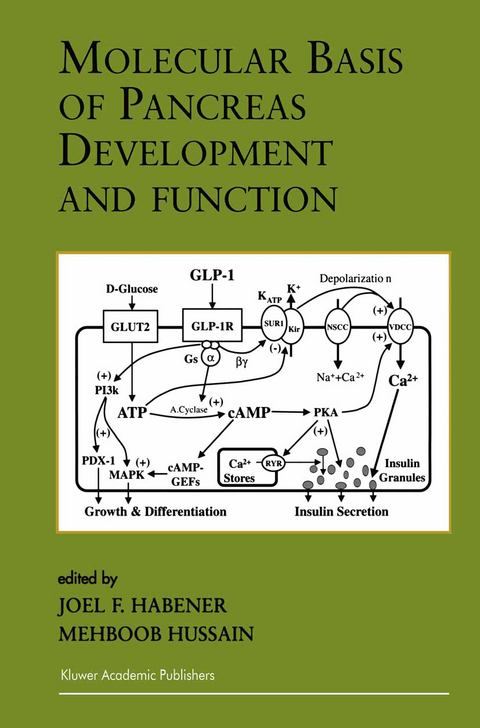
Molecular Basis of Pancreas Development and Function
Springer (Verlag)
978-0-7923-7271-4 (ISBN)
Diabetes mellitus is rapidly increasing in prevalence throughout both developed and developing countries. The social and economic burden of this disease is estimated to cost 14 billion dollars worldwide. In the USA alone, 15 million individuals are diabetic, nearly half of them unaware of their condition. Complications of diabetes mellitus are the leading causes for blindness, limb amputation and chronic renal failure and kidney transplantation in industrialized countries. Further, diabetes mellitus per se and the metabolic derangement associated with diabetes are important risk factors for cardiovascular disease. Diabetes, as defined by an elevated fasting blood glucose level is presently subdivided in etiologically distinct groups. The most prevalent being type 2 (adult onset) diabetes characterized by insulin resistance and failure of the ~-cell to supply insulin in amounts sufficient to meet the body's needs. Type 1 (juvenile) diabetes, most commonly with an onset during childhood and adolescence, is caused by an auto-immune destruction of the pancreatic ~-cells. The causations of both type 1 and type 2 diabetes involve a combination of complex genetic traits and environmental influences. A third category are the mature onset diabetes of the young (MODY). This comparatively small group of patients (-10% of diabetes) presents relative early in life «30 years of age) compared to the more common late onset type 2 diabetes.
1. An Historical and Phylogenetic Perspective of Islet-Cell Development.- 2. Glucose Signalling to Transcription Factors of the Insulin Gene.- 3. ?-Cell Dysfunction and Chronic Hyperglycaemia.- 4. Glucose Toxicity of the Pancreatic ?-cell.- 5. The ?-Cell and Regulation of Glucagon Gene Transcription.- 6. The KATP Channel and the Sulfonylurea Receptor.- 7. Glucagon-Like Peptide-1: An Insulinotropic Hormone with Potent Growth Factor Actions at the Pancreatic Islets of Langerhan.- 8. Communication of Islet Cells: Molecules and Functions.- 9. Soluble Factors Important for Pancreas Development.- 10. Role of Mesenchymal-Epithelial Interactions in Pancreas Development.- 11. Homeodomain Proteins in Pancreas Development.- 12. bHLH Factors and Notch in Pancreatic Development.- 13. Identification, Biological Functions, and Contribution to Human Diabetes of Islet-Brain 1.- 14. Pax4 and Pax6 in Islet Differentiation.- 15. The Role of the Hepatocyte Nuclear Factor Network in Glucose Homeostasis.- 16. Regulation of PDX-1 Gene Expression.- 17. Mechanisms of Postnatal ?-Cell Mass Regulation.- 18. Genetic Models of Insulin Resistance: Alterations in ?-Cell Biology.- 19. Clinical Consequences of Genetic Defects in ?-Cell Genes.- 20. Pathophysiology of Glut2 in Diabetes Mellitus.- 21. Use of a Cre-LoxP Strategy in Mice to Determine the Cell-Specific Roles of Glucokinase in MODY-2.- 22. Development of ?-Cell Lines for Transplantation in Type 1 Diabetes Mellitus.- 23. Gene Therapeutic Approaches for ?-Cell Replacement.- Colour Figures.
| Erscheint lt. Verlag | 31.1.2001 |
|---|---|
| Reihe/Serie | Endocrine Updates ; 11 |
| Zusatzinfo | XIV, 412 p. |
| Verlagsort | Dordrecht |
| Sprache | englisch |
| Maße | 155 x 235 mm |
| Themenwelt | Medizinische Fachgebiete ► Innere Medizin ► Diabetologie |
| Medizinische Fachgebiete ► Innere Medizin ► Endokrinologie | |
| Medizin / Pharmazie ► Medizinische Fachgebiete ► Pädiatrie | |
| Studium ► 1. Studienabschnitt (Vorklinik) ► Physiologie | |
| ISBN-10 | 0-7923-7271-9 / 0792372719 |
| ISBN-13 | 978-0-7923-7271-4 / 9780792372714 |
| Zustand | Neuware |
| Haben Sie eine Frage zum Produkt? |
aus dem Bereich


